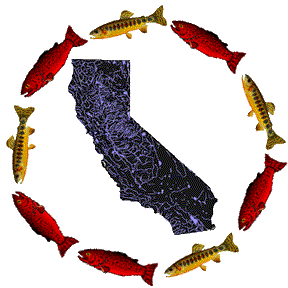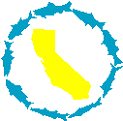|
CSPA |
| "A rescue effort of this size is unprecedented in recent history and, while every attempt is being made to identify the best possible practices, the operation may require innovation and flexibility to be successful. Even with the rescue effort, it is believed that large numbers of fish will perish, some in the capture and transport and others, escaping the rescue efforts, dieing in the lake's remaining pool during the winter period." |
| Your 501(c)(3) tax deductible cash donations are desperately needed if the fight for our fisheries is to continue. Read how you can donate! |

 More
News
More
News
![]()

 CSPA/TU
News
CSPA/TU
News
Caples Lake fish rescue volunteer list approaching 50, deadline to apply Tuesday midnight. Additional volunteers may be sought to fill out work schedule
Follow this link for Volunteer Application
by Jerry Neuburger
August 19, 2008. -- As of 6AM Tuesday morning, close to 50 volunteers
have stepped forward to assist DFG in the coming fish rescue at Caples
Lake in the Sierras. The rescue, extending over four days and operating
for 72 hours around the clock, will be one of the most massive attempts
to rescue a fishery in recent memory. The rescue is necessary since
Caples is being drained to repair the dam's aging slide gates.
A volunteer application deadline of Tuesday night midnight has been set so that Chris Shutes, FERC Projects Director for CSPA and Barbara Bania of the Sac-Sierra Chapter of Trout Unlimited, can work with DFG in preparing a work schedule, integrating the volunteers as efficiently as possible with the 35 member DFG staff supervising the rescue. Volunteers will assist in the work of electrofishing, moving fish, counting and measuring, and general assistance.
Once the schedule is prepared, a second call for volunteers may take place to fill in any voids where DFG believes more assistance may be necessary. That request, if necessary will be put out Wednesday night or sometime during the day on Thursday.
The issue of the repairs and the "emergency" nature of the issue have been a point of contention between area residents, businesses, fishermen and the El Dorado Irrigation District (EID), owners of the dam. EID purchased the dam in 1999, when PG&E sold off many of their Sierra hydro projects. In addition to the Caples operation, EID also purchased the Silver Lake project, seven miles west and lower in elevation.
According to the EID website, "On July 1, the El Dorado Irrigation District’s Board of Directors declared an emergency after a mid-June underwater investigation at Caples Lake revealed major problems with two slide gates. The gates are located in a well-like shaft within the dam. Of particular concern is the lower gate that is about 64 feet under water when the lake is full."
The repairs were originally scheduled for the fall of 2009, however in early July, the district found a manufacturer that could furnish the necessary parts for the repairs in time to complete them in 2008. However to do so, the district would need to bypass all of the necessary review procedures required by various agencies.
To facilitate the repairs, EID declared an emergency situation. By declaring an “emergency,” it allowed reviewing agencies to sign off on their responsibilities, the environmental review process was bypassed and there was no formal process or independent review evaluating alternatives that might avoid or lessen impacts to the lake's fishery or the impact on local businesses.
A controversy began when area businesses, residents and anglers learned that EID's plan for repairs would necessitate the draw down of the lake to a minimum that would almost guarantee the death of the fishery. The lake is considered to be one of the "jewels" of the Sierra due to the large and varied population of trout that the lake supports. The small pool left from the lake's 22,500 acre feet maximum is believed to be inadequate to allow the lakes fish population to winter over because of the severe winter freeze and lack of oxygen resulting.
Had normal procedures been followed, EID would have had to walk through the steps required by the California Environmental Quality Act (CEQA) which would have required review by a number of agencies and allowed for public input.
The hearing would have brought out local businesses and fishermen and would have provided a forum for investigating potential alternatives that would possibly avoid or lessen adverse consequences. Could the project be conducted next year following environmental review? Could a higher cofferdam be constructed? Could a bladder be placed in the outlet tunnel allowing a dry repair? Could the lake be oxygenated?
Once committed to the draw down, it was questionable whether a fish rescue was feasible. However after some deliberation, DFG and EID agreed to attempt the same and to transport rescued fish to Silver Lake, seven miles west of Caples. When the rescue attempt was made known at a recent meeting, David Lass of Truckee, Northern California field coordinator for Trout Unlimited, offered the services of his organization to help in the project.
Chris Shutes, CSPA FERC Projects Director attended a following meeting to review the entire situation since Caples Lake is part of a hydroelectric project licensed by Federal Energy Regulatory Commission as project 184. The rapid sequence of events, including the approval of the emergency status of the project led CSPA to determine that while the repairs had been to some extent, railroaded, intervention attempts were now beyond any realistic chance of success.
While CSPA felt that due process was needlessly put aside, the best option seemed to be to support the rescue efforts and, at the same time, further investigate the situation on Silver Lake where similar repairs are necessary to the dam. These repairs are scheduled for 2009, and do not require such drastic measures. However, that is no guarantee that the fishery in Silver Lake will not be impacted by the lake's repairs. CSPA will consider seeking full CEQA review before allowing the Silver Lake repairs to go forward.
Chris Shutes contacted Trout Unlimited and DFG, and volunteered to provide CSPA's website as a rallying point in the callout for volunteers. Chris was referred to Barbara Bania, of the Sac-Sierra Chapter of TU for local support. In addition, Shutes, and Jerry Neuburger, CSPA's webmaster have committed themselves to oversee and assist in the rescue operation from start to finish.
A rescue effort of this size is unprecedented in recent history and, while every attempt is being made to identify the best possible practices, the operation may require innovation and flexibility to be successful. Even with the rescue effort, it is believed that large numbers of fish will perish, some in the capture and transport and others, escaping the rescue efforts, dieing in the lake's remaining pool during the winter period.
As a concession to the area businesses and Sierra fishermen, EID is proposing to restock Caples Lake at double the fish per acre that are being put back into Davis Lake. Mackinaws will be replaced; a quarantine of lake trout, which all come from out of state, means that this can only be done with fingerlings. About 6000 rainbows and 6000 browns over 2½ pounds will be put in the lake, half as soon as the lake has enough water to support them and is ice free, and the other half over the summer of 2009. Plus a bunch of regular planters and fingerlings.
The mitigation would continue for ten years, and is in addition to DFG stocking and an existing supplemental stocking program that is overseen by the Environmental Review Commission. This proposal however has not been approved by the EID Board of Directors and is scheduled to be heard August 25, the day before the rescue efforts begin. CSPA will closely follow the results of this meeting and review if the proposed stocking program is adequate.